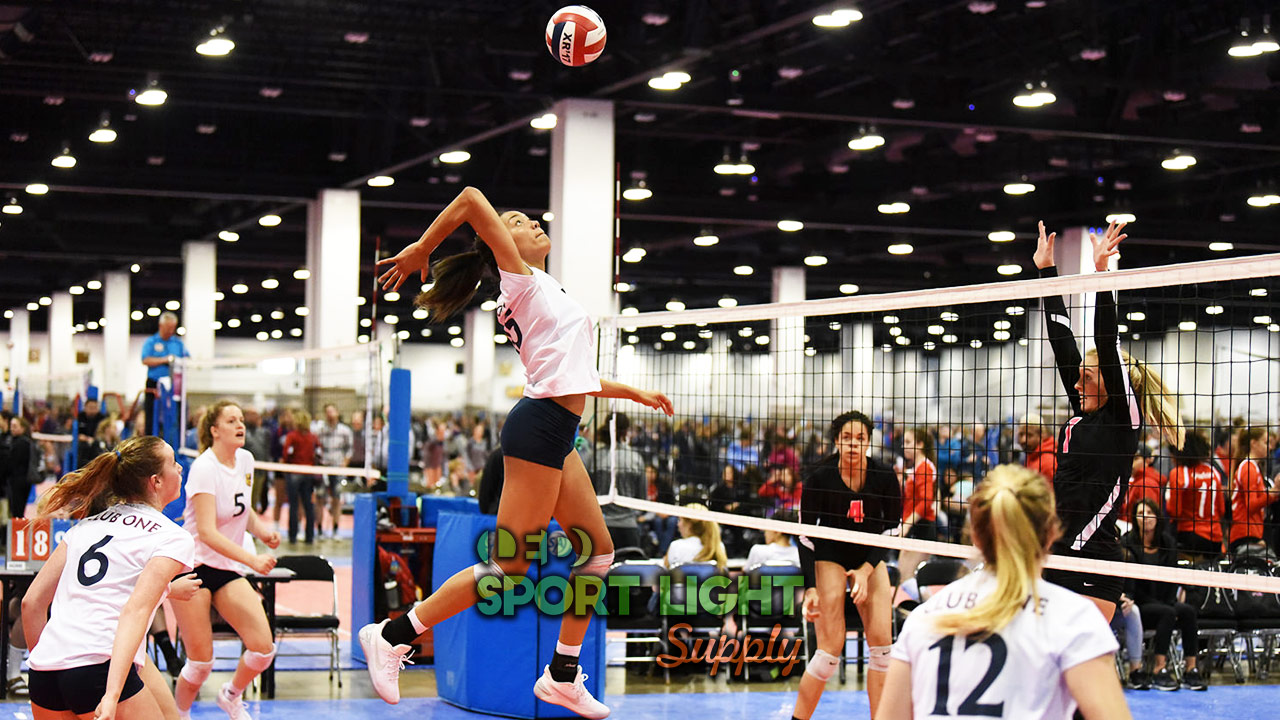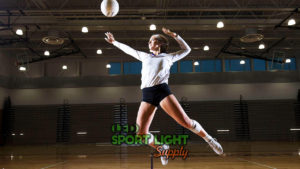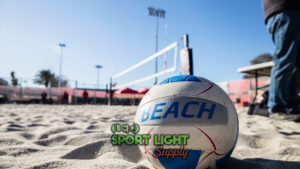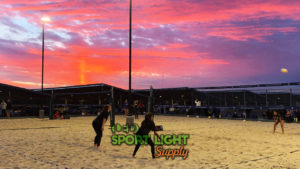What lights are used in indoor volleyball courts?
1. High bay flood lights
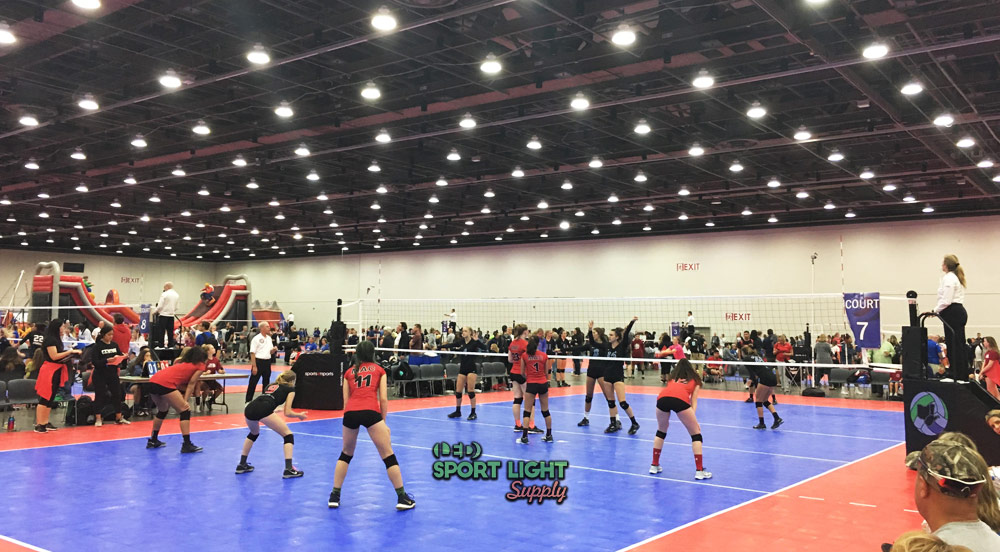
High bay lights are the most common light fixtures in indoor volleyball facilities. Ordinarily, the standard design includes a hook, a chain, and a lamp holder. It is easy to install these flood lights by fixing them to the wall or hanging them from a bracket.
For one thing, the price point of each high bay light might not be cheap. But usually, installing a bunch of them is less expensive than choosing other professional lights. They are ideal for the volleyball lighting layout because they provide a broad angle beam and mount energy-saving LED lamps. In detail, you can choose between a beam angle of 45, 60, and 90 degrees to provide broad light distribution and proper illumination of the volleyball court.
2. Panel lights
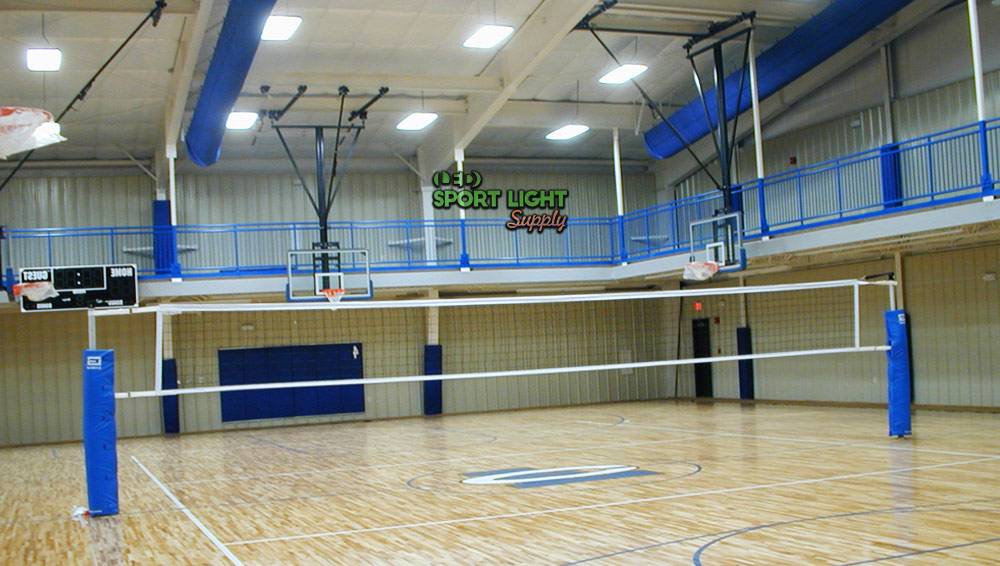
The typical panel light includes a diffuser to soften the luminous flux. From a technical perspective, this feature can improve lighting uniformity and reduce glare.
The standard LED panel design is flat. To be precise, these panels are thin, which would not be possible without LED technology. Plus, they do not stand out. So, you could also say that they are modern and minimalist.
LED panels are available in two versions: recessed and ceiling mounted ones. Of course, the recessed panels are inserted into the ceiling and give you a more aesthetic feel of modern sports arenas. Usually, LED panels are inserted into a hole made in the plasterboard. Especially by using clips on the lamp and/or mounting kits such as frames.
3. Light tubes
These light fixtures are extremely lightweight and easy to install. On the other hand, they are not very bright. So, hundreds of tubes on the volleyball court ceiling are necessary to illuminate from the service area to the center line.
The lighting layout becomes essential to provide the correct lux level in any part of the pitch. Especially for the attack lines and the back rows.
A large variety of models and types of light tubes exists. In detail, they can cost anywhere between a few bucks and up to $ 400 or more per lot. Unfortunately, each lot or pack may contain a different set of cheap or expensive models. On the market, fluorescent and LED light tubes are the most common types at the moment.
Indoor volleyball court lighting design and layout
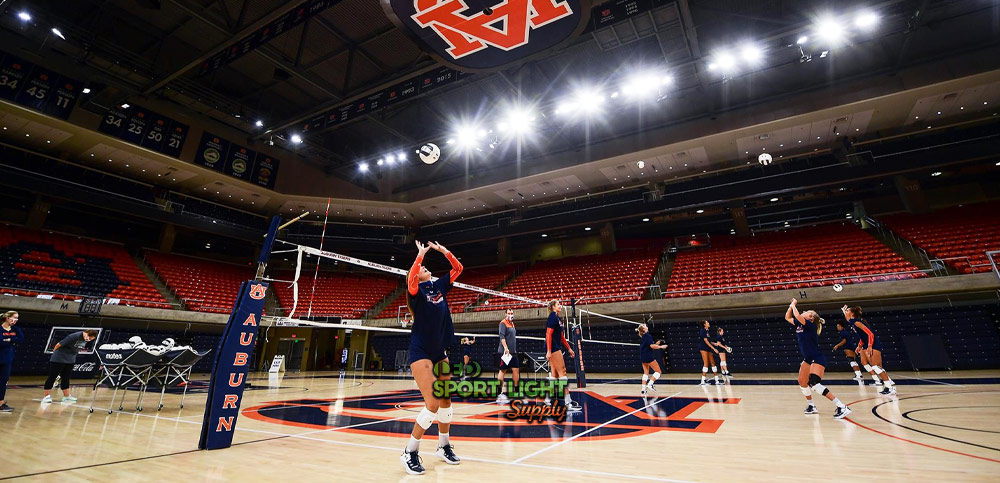
1. Average ceiling height of indoor volleyball court
According to your association’s rules, the average ceiling height of a volleyball court may change. For example, the USA Volleyball organization requires a minimum ceiling height of 23 ft (7 m). This applies to high school sports facilities as well.
The lighting design and layout should adapt to the volleyball net height. To specify, according to each age group, the net height varies. For example, 10-year-old players need a lower net height than 18-year-old or adult players.
The indoor ceiling height must ensure all sorts of play and situation. For instance, a high free ball that the defending team could not turn into a spike. Or a high underhand serve.
2. Direct or indirect lighting
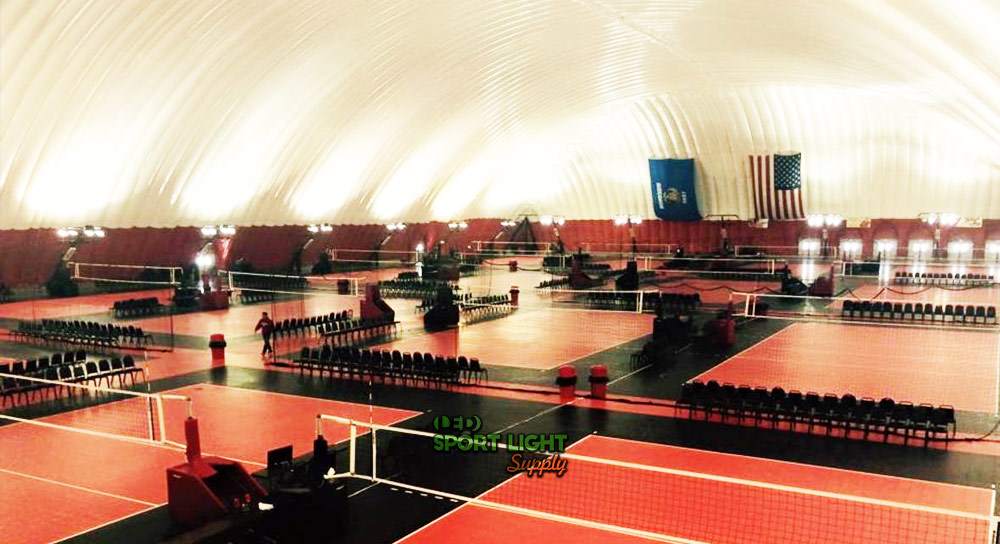
Direct lighting means the lights are pointing downward. By contrast, indirect lighting refers to the lights pointing upward. In the latter case, the floodlights use the reflected glow to light up the volleyball court.
Indirect lighting is increasingly widespread in volleyball facilities. The diffusion of light fills the entire environment creating a better distribution. Moreover, indirect light can be implemented in any gym with different types of luminaires. But to be truly effective, it should be foreseen from the very beginning in the architectural project. In any other case, indirect lighting alone is not sufficient to provide the right light intensity. So, it must be complementary to the central, direct light source(s).
3. Lux requirement
a) Recreational: 200 lux
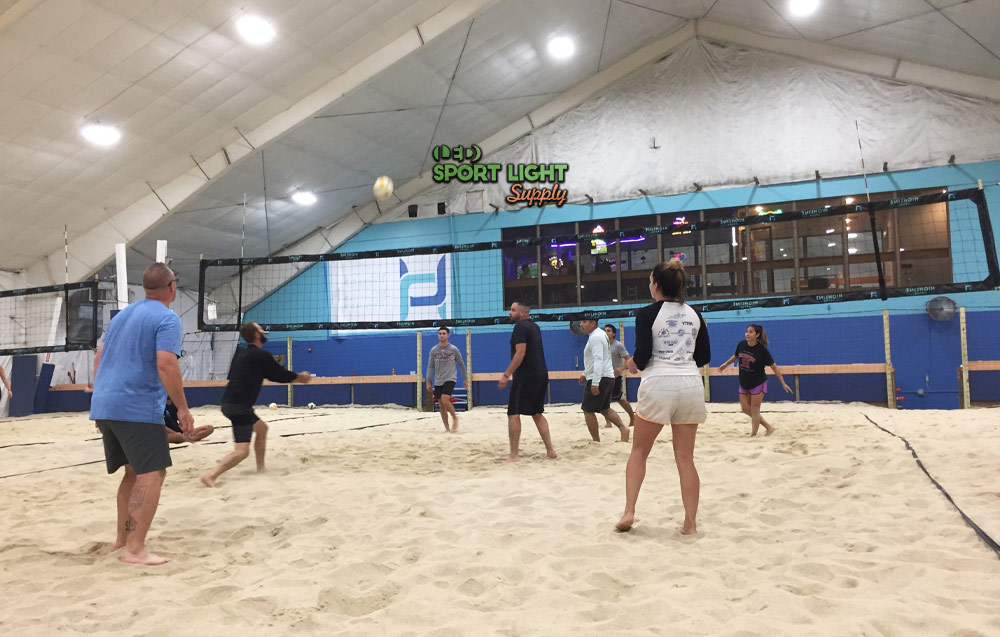
At least 200 lux are necessary for training with a W serve-receive formation. Usually, volleyball drills include practicing basic skills, such as:
- serve
- set
- hit
- pass
- block
- defense
- dig
As well as practicing transition, quick sets, and several formations.
This lighting standard does not include any spectator. Besides, it is also suitable for training at home or any other sports facility.
Anyone can achieve such an elementary lux level with cheap LED lights. In detail, the running cost of 200 lux is almost negligible. Basically, the lighting layout requires one high-power high bay LED light right above the center line. Or two less expensive panel lights above each side of the volleyball court.
b) High school or college gymnasium: 300 to 500 lux
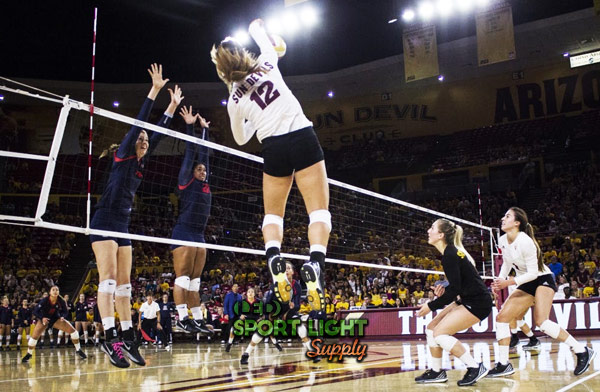
Coaching a volleyball team involves training young athletes and trying to reach a well-defined goal. To this end, each volleyball coach must work on the players’ motivation and technical skills. Thus, the lighting layout must ensure the students’ safety at all times. Usually, the lighting design of a high school or college gym uses up to six recessed panel lights per volleyball court.
Such a lux level is ideal for training both the team and specialists. For example, a libero or other key players.
Operating costs depend on the overall volleyball training program. As well as the coach’s methodology and total hours of training. In fact, for a cross-court game, half lights would do.
c) Broadcasting: 800 to 1000 lux
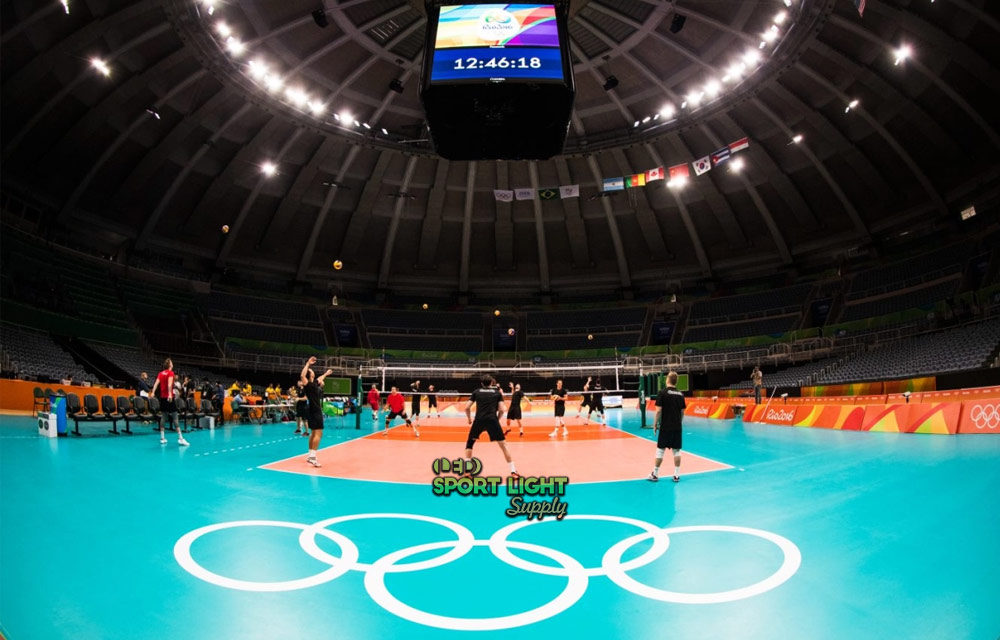
In a television studio with multiple cameras, general lighting is ok. Mainly, the goal is to attenuate the contrast of a scene. So, adding more light sources can reinforce and/or replace the fill light. Usually, these lights come from above to avoid problems with the movement of the cameras.
Similarly, 800 to 1000 lux are necessary for a volleyball court. The lighting design and layout still make use of vertical lighting. But at the same time, it can include spotlights and other light sources to balance the effect of the primary light source.
Carefully controlling the intensity of the lights is of uttermost importance. So, remote lighting control becomes essential to adjust to the broadcasters’ needs. Especially during timeouts and tie-breaking sets.
4. Lighting uniformity
An indoor volleyball court needs lighting uniformity values between 0.5 and 0.7. Mainly to avoid abrupt shady and bright areas.
Most focus-intensive plays rely on the players’ ability to shift position and role. For example, a cross-court attack that calls for a cover from nearby teammates. In these instances, light distribution plays a fundamental role both in vertical and horizontal illuminance.
Ensuring optimal lighting uniformity on every part of the volleyball court may raise the electric bill. On the other hand, you could go for the lowest minimum recommended. But you would do so at the cost of much-reduced vision and lower safety standards.
Lighting uniformity is an integral part of the lighting design. In short, it requires volleyball facility owners to install and maintain high-quality light fixtures to host official matches.
5. Spacing between the volleyball court ceiling lights (the lighting layout)
For most levels of competition, a spacing of 3 to 5 meters between the lights is required. This functional distance ensures the best results. That is, it helps to distribute the luminous intensity evenly on a uniform grid.
A lighting designer can calculate the precise spacing by taking into account the dimensions of the actual facility. To do that, professionals like us create a photometric report analysis with the use of the latest software.
Normally, the lighting layout changes according to the type of light source. For example, LED high bay lights can require more spacing than fluorescent light tubes. In fact, the ultimate goal is meeting both the players’ and spectators’ expectations at the same time, from their perspective and positions.
Indoor volleyball court lighting cost
The cost analysis of a professional lighting system for an indoor volleyball court depends on:
- lux required
- volleyball court size
- ceiling height
- light source (LED/metal halide/fluorescent/etc)
Maintenance costs could also be a leading factor. So, ultimately, the light source price point per se is not indicative of its actual value. Renovating an old lighting system could also be expensive.
Sometimes, retrofitting a sports arena with cheap floodlights can be a temporary solution. But for more reliable emergency lighting, light towers could also be a better option.
The utilization rate of the gym or volleyball facility will shorten the life span of the light sources. Just so you know, different light sources have varying life spans. At this moment, LED is the most long-lasting light source. Instead, halogen lamps have the shortest life span of all.
How to calculate indoor volleyball court lighting cost?
Here is a rough estimate of the volleyball court lighting cost. For starters, the volleyball court size is 18 x 9m, which totals 162 sq. meter.
Because the lux required for high school or college volleyball activities is 500 lux, this means that we must calculate the following:
500 lux (the lighting standard) x 162 sq. meter (the area) x 1.2 (light loss factor) = 97,200 lumens
Now, let us turn that lumen output into wattage. In this way, you can determine how many lights you need to buy. Of course, the light source type will influence the price of the light fixtures as well as the running costs:
- LED volleyball court lights have the highest lumen per watt ratio, so: 97,200 lumens/150 lumens per watt = 648W
- Metal halide are somewhat in between: 97,200 lumens/65 lumens per watt = 1,495W
- Halogen bulbs have the least light-efficiency, so they require: 97,200 lumens/15 lumens per watt = 6,480W
Thus, the cost of this indoor LED volleyball court lighting design is:
648W x $0.8 to $1.5 = $518.4 to $972.
Lastly, you also need to consider the dispatch cost to your gym, facility, or place. In this case, add 5% (for urban locations) or 15% (for remote areas) of the total light cost, depending on your position.

